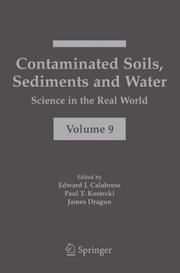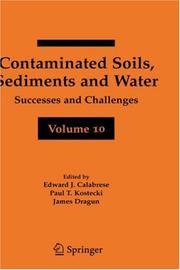| Listing 1 - 7 of 7 |
Sort by
|
Book
ISSN: 10588337 Year: 1997 Publisher: Boca Raton Lewis
Abstract | Keywords | Export | Availability | Bookmark
 Loading...
Loading...Choose an application
- Reference Manager
- EndNote
- RefWorks (Direct export to RefWorks)
Digital
ISBN: 9780387230795 Year: 2005 Publisher: Boston, MA Springer Science + Business Media, Inc
Abstract | Keywords | Export | Availability | Bookmark
 Loading...
Loading...Choose an application
- Reference Manager
- EndNote
- RefWorks (Direct export to RefWorks)
Water supply. Water treatment. Water pollution --- zware metalen --- bodemkunde --- verontreiniging --- bodembescherming --- waterverontreiniging --- milieubeleid --- milieuzorg --- milieubeheer --- milieuanalyse
Digital
ISBN: 9780387283241 Year: 2006 Publisher: Boston, MA Springer Science+Business Media, Inc
Abstract | Keywords | Export | Availability | Bookmark
 Loading...
Loading...Choose an application
- Reference Manager
- EndNote
- RefWorks (Direct export to RefWorks)
General microbiology --- Water supply. Water treatment. Water pollution --- Soil pollution. Soil purification --- Pedology --- bodemkunde --- verontreiniging --- bodembescherming --- microbiologie --- waterverontreiniging

ISBN: 1280427515 9786610427512 0387230793 038723036X 1441935681 Year: 2005 Publisher: New York : Springer Science+Business Media,
Abstract | Keywords | Export | Availability | Bookmark
 Loading...
Loading...Choose an application
- Reference Manager
- EndNote
- RefWorks (Direct export to RefWorks)
Increasingly in the environmental industry we are reminded how much we are part of the real world. Global economic pressures, geopolitical uncertainty, business ethics, and other world dynamics exert enormous pressure on our academic, industrial, governmental or consulting work venues. Yet, often these pressures have challenged us to produce scientific and engineering solutions that are more focused, cost-effective and readily implemented. The environmental remediation industry in general has responded well. Perhaps the growing alliance movement in business today is a signpost for another important opportunity. Collaborations enable entities to focus on what they do best and rely on others to do the same. Such collaborations build trust and encourage more strategic thinking. Contaminated Soils Volume 9 contains 38 technical papers, covering a wide range of environmental issues. Volume discussion includes: Part I Bioremediation; Part II Chemical Oxidation; Part III Heavy Metals; Part IV MTBE; Part V Phytoremediation; Part VI Radiation; Part VII Regulatory and Legal issues; Part VIII Remediation; Part IX Risk Based Cleanup; and Part X Site Assessment. Contributing authors to this volume are from government agencies, academic institutions, the consulting community and industrial companies. This important volume documents the state of environmental science and provides perspective on where we as an industry have come from. Increased scientific, engineering and consulting alliances and collaboration should drive our efforts going forward.
Soil remediation. --- Water --- Purification. --- Effluent treatment --- Purification of water --- Water purification --- Water treatment --- Sanitation --- Water quality management --- Water-supply --- Cleanup of contaminated soil --- Remediation of contaminated soil --- Soil cleanup --- Soil contamination remediation --- Soil protection --- Soil pollution --- Environmental pollution. --- Environmental toxicology. --- Environmental management. --- Soil conservation. --- Terrestrial Pollution. --- Water Quality/Water Pollution. --- Ecotoxicology. --- Waste Water Technology / Water Pollution Control / Water Management / Aquatic Pollution. --- Environmental Management. --- Soil Science & Conservation. --- Conservation of soil --- Erosion control, Soil --- Soil erosion --- Soil erosion control --- Soils --- Agricultural conservation --- Soil management --- Environmental stewardship --- Stewardship, Environmental --- Environmental sciences --- Management --- Ecotoxicology --- Pollutants --- Pollution --- Environmental health --- Toxicology --- Chemical pollution --- Chemicals --- Contamination of environment --- Environmental pollution --- Contamination (Technology) --- Asbestos abatement --- Bioremediation --- Environmental engineering --- Environmental quality --- Factory and trade waste --- Hazardous waste site remediation --- Hazardous wastes --- In situ remediation --- Lead abatement --- Refuse and refuse disposal --- Control --- Prevention --- Conservation --- Environmental aspects

ISBN: 1280462191 9786610462193 0387283242 0387283226 1441939377 Year: 2006 Publisher: New York : Springer,
Abstract | Keywords | Export | Availability | Bookmark
 Loading...
Loading...Choose an application
- Reference Manager
- EndNote
- RefWorks (Direct export to RefWorks)
Contaminated Soils, Sediments and Water: Successes and Challenges, Volume 10 contains a valuable collection of success stories (and challenges) in the areas of environmental fate, heavy metals, modeling, MTBE and oxygenates, regulatory, remediation, risk assessment, site assessment and sampling methodology. It demonstrates the progress that has been made in working together toward the optimization of established approaches, as well as embracing departures from traditional regulatory models in order to address the threats to our natural resources. The book is divided into eight sections: Part I: Environmental Fate; Part II: Heavy Metals; Part III: Modeling; Part IV: MTBE and Oxygenates; Part V: Radionuclides; Part VI: Regulatory; Part VII: Remediation; Part VIII: Risk Assessment and Remedial Approaches Towards Restoration and Management of Contaminated Rivers. Contributing authors to Contaminated Soils, Sediments and Water: Successes and Challenges, Volume 10 are from government agencies, academic institutions, the consulting community and industrial companies. They document the state of environmental science and provide perspective on the progress that has occurred.
Soil remediation --- Water --- Purification --- Environmental pollution. --- Soil conservation. --- Microbiology. --- Waste Water Technology / Water Pollution Control / Water Management / Aquatic Pollution. --- Soil Science & Conservation. --- Water Quality/Water Pollution. --- Terrestrial Pollution. --- Microbial biology --- Biology --- Microorganisms --- Conservation of soil --- Erosion control, Soil --- Soil erosion --- Soil erosion control --- Soils --- Agricultural conservation --- Soil management --- Chemical pollution --- Chemicals --- Contamination of environment --- Environmental pollution --- Pollution --- Contamination (Technology) --- Asbestos abatement --- Bioremediation --- Environmental engineering --- Environmental quality --- Factory and trade waste --- Hazardous waste site remediation --- Hazardous wastes --- In situ remediation --- Lead abatement --- Pollutants --- Refuse and refuse disposal --- Control --- Prevention --- Conservation --- Environmental aspects --- Water pollution. --- Soil science. --- Water quality. --- Freshwater --- Freshwater quality --- Marine water quality --- Quality of water --- Seawater --- Seawater quality --- Pedology (Soil science) --- Agriculture --- Earth sciences --- Aquatic pollution --- Fresh water --- Fresh water pollution --- Freshwater pollution --- Inland water pollution --- Lake pollution --- Lakes --- Reservoirs --- River pollution --- Rivers --- Stream pollution --- Water contamination --- Water pollutants --- Water pollution --- Waste disposal in rivers, lakes, etc. --- Quality --- Composition
Book
ISBN: 9780387230795 Year: 2005 Publisher: Boston MA Springer US
Abstract | Keywords | Export | Availability | Bookmark
 Loading...
Loading...Choose an application
- Reference Manager
- EndNote
- RefWorks (Direct export to RefWorks)
Increasingly in the environmental industry we are reminded how much we are part of the real world. Global economic pressures, geopolitical uncertainty, business ethics, and other world dynamics exert enormous pressure on our academic, industrial, governmental or consulting work venues. Yet, often these pressures have challenged us to produce scientific and engineering solutions that are more focused, cost-effective and readily implemented. The environmental remediation industry in general has responded well. Perhaps the growing alliance movement in business today is a signpost for another important opportunity. Collaborations enable entities to focus on what they do best and rely on others to do the same. Such collaborations build trust and encourage more strategic thinking. Contaminated Soils Volume 9 contains 38 technical papers, covering a wide range of environmental issues. Volume discussion includes: Part I Bioremediation; Part II Chemical Oxidation; Part III Heavy Metals; Part IV MTBE; Part V Phytoremediation; Part VI Radiation; Part VII Regulatory and Legal issues; Part VIII Remediation; Part IX Risk Based Cleanup; and Part X Site Assessment. Contributing authors to this volume are from government agencies, academic institutions, the consulting community and industrial companies. This important volume documents the state of environmental science and provides perspective on where we as an industry have come from. Increased scientific, engineering and consulting alliances and collaboration should drive our efforts going forward.
Water supply. Water treatment. Water pollution --- zware metalen --- bodemkunde --- verontreiniging --- bodembescherming --- waterverontreiniging --- milieubeleid --- milieuzorg --- milieubeheer --- milieuanalyse
Book
ISBN: 9780387283241 Year: 2006 Publisher: Boston MA Springer US
Abstract | Keywords | Export | Availability | Bookmark
 Loading...
Loading...Choose an application
- Reference Manager
- EndNote
- RefWorks (Direct export to RefWorks)
Contaminated Soils, Sediments and Water: Successes and Challenges, Volume 10 contains a valuable collection of success stories (and challenges) in the areas of environmental fate, heavy metals, modeling, MTBE and oxygenates, regulatory, remediation, risk assessment, site assessment and sampling methodology. It demonstrates the progress that has been made in working together toward the optimization of established approaches, as well as embracing departures from traditional regulatory models in order to address the threats to our natural resources. The book is divided into eight sections: Part I: Environmental Fate; Part II: Heavy Metals; Part III: Modeling; Part IV: MTBE and Oxygenates; Part V: Radionuclides; Part VI: Regulatory; Part VII: Remediation; Part VIII: Risk Assessment and Remedial Approaches Towards Restoration and Management of Contaminated Rivers. Contributing authors to Contaminated Soils, Sediments and Water: Successes and Challenges, Volume 10 are from government agencies, academic institutions, the consulting community and industrial companies. They document the state of environmental science and provide perspective on the progress that has occurred.
General microbiology --- Water supply. Water treatment. Water pollution --- Soil pollution. Soil purification --- Pedology --- bodemkunde --- verontreiniging --- bodembescherming --- microbiologie --- waterverontreiniging
| Listing 1 - 7 of 7 |
Sort by
|

 Search
Search Feedback
Feedback About UniCat
About UniCat  Help
Help News
News